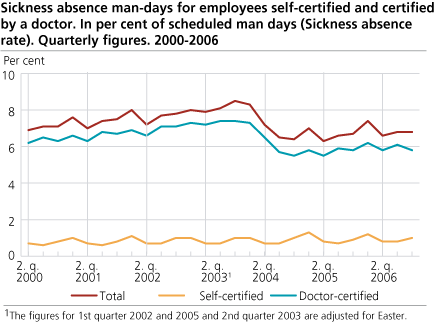Content
Published:
This is an archived release.
Moderate increase in sickness absence
Doctor-certified sickness absence remained unchanged at 5.8 per cent from the fourth quarter of 2005 to the fourth quarter of 2006, while self-certified absence increased from 0.9 to 1.0 per cent.
The sickness absence for women rose from 8.4 to 8.6 per cent, while it remained stable at 5.4 per cent for men.
The total sickness absence increased by 1.0 per cent from the fourth quarter of 2005 to the fourth quarter of 2006. This represents a decline in the yearly growth rate which, which was 3.3 per cent in the last quarter. The sickness absence was 9.1 per cent lower than in the fourth quarter of 2001, the year when the agreement on a more inclusive labour market was implemented.
Strongest decrease in financial services
The decrease in sickness absence was largest in financial services and transport and communication, with 3.0 and 2.7 per cent respectively. Education and health and social work had the highest increases with 2.7 and 2.3 per cent respectively.
Strongest increase in Vestfold county
Vestfold, Østfold and Buskerud and Sogn og Fjordane counties had the highest increase in sickness absence, with 5.5, 3.8, 3.7 and 3.6 per cent respectively between the fourth quarter of 2005 and the fourth quarter of 2006. The sickness absence fell by 1.8 per cent in Telemark and 0.8 per cent in Hordaland in the same period.
Decreasing proportion of long-lasting absences
The proportion of doctor-certified sickness absence lasting more then 31 days fell from 61.7 to 60.7 per cent in the third quarter of 2006. The proportion of self-certified sickness absence rose from 13.5 per cent to 14.1 per cent from the fourth quarter of 2005 to the fourth quarter of 2006.
Strongest increase in Central government
The sickness absence increased in all sectors. The strongest growth was in central government, including state hospitals, with 2.1 per cent. Within this sector, the sickness absence increased by 4.0 per cent in health care (mainly state hospitals) and 3.7 per cent in education (universities and colleges).
The private sector and public enterprises had the lowest growth with 0.8 per cent. Within this sector, the sickness absence in health care rose by 2.7 per cent.
The sickness absence increased by 1.4 per cent in local government. Education pulled the average for this sector upwards with an increase of 2.6 per cent, while public administration had a decrease of 2.8 per cent.
Rise among the youngest
The highest increase in doctor-certified sickness absence was found among 16-19 year olds. However, this is a relatively small group. The sickness absence increased by 6.3 per cent among 20-24 year olds and 1.4 per cent in the age group 25-29. The sickness absence decreased by 0.9 per cent among the 50-54 year olds.
The sickness absence rate measures the proportion of scheduled man-days lost due to own sickness. The statistics do not cover self-employed persons.
Tables:
- Table 1 Sickness absence man-days for employees self-certified and certified by a doctor. In per cent of scheduled man-days (Sickness absence rate). Quarterly figures. 2000-2006
- Table 2 Sickness absence man-days for employees self-certified and certified by a doctor, by sex. In per cent of scheduled man-days (Sickness absence rate). Quarterly figures. 2000-2006
- Table 3 Sickness absence man-days for employees self-certified and certified by a doctor, by industry and type of sickness absence. In per cent of scheduled man days (Sickness absence rate). Quarterly figures. 2000-2006
- Table 33 Change in per cent of the sickness absence rate for employees self-certified and certified by a doctor, by industry and type of sickness absence. Quarterly changes. 2000-2006
Contact
-
Arbeidsmarked og lønn
E-mail: arbeidsmarked@ssb.no
-
Unn H. Høydahl
E-mail: unnh.hoydahl@ssb.no
tel.: (+47) 40 90 23 77

